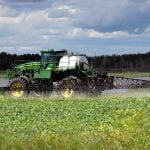BRANDON – As awareness of hardpan increases, more companies have introduced sub-soilers to bust up the solid layer that prevents moisture, nutrients and roots from accessing the untapped soil below.
The common assumption has been that severe prairie winter conditions are bad enough to freeze and fracture the hardpan layer.
But that’s not true, said Doug Bidulock, marketing director for AgrowPlow in Canada.
“We’ve assumed wrong all these years.”
Bidulock said frost can break up hardpan to a certain extent, but the nature of hardpan prevents frost from working the way many think it should.
Read Also

VIDEO: Green Lightning and Nytro Ag win sustainability innovation award
Nytro Ag Corp and Green Lightning recieved an innovation award at Ag in Motion 2025 for the Green Lightning Nitrogen Machine, which converts atmospheric nitrogen into a plant-usable form.
“Frost needs water to work. Water goes into the soil only to the depth that it can’t penetrate any deeper. At that depth, you’ll see the frost.
“But if water and frost can’t actually penetrate into the hardpan layer itself, then they don’t have the ability to break it up.
“We’ve seen canola fields in Alberta where the roots hit the hardpan and then go totally horizontal sideways. We’ve even seen Canada thistle roots that hit the hardpan and go totally sideways. Roots just follow along the top of the hardpan layer.”
Bidulock said most AgrowPlow customers use its plow every three to six years per field.
Some use it more often in heavy traffic areas such as headlands and field approaches.
“On cereals, some of our Alberta customers report a 10 to 15 bushel yield increase the year after they’ve done the field with our plow.”
Bidulock said the plows are also popular for use in breaking up the bottoms of sloughs and potholes. The hardpan layer at the bottom prevents standing water from seeping into the soil below, making the spot impossible to farm most years.
“Some of our Alberta producers have said they run the AgrowPlow through their problem potholes or boggy areas in the fall and they’re able to seed right into them the next spring.
“The ring around your sloughs has gotten a lot of traffic over the years, so it’s more highly compacted. It might require two trips to rip up the hardpan. If you’re able to grow crops in these spots where you couldn’t grow before, that’s significant.”
Bidulock said hardpan on the Prairies starts shallow in some areas at six or eight inches for the top layer while in other areas it runs as deep as 18 inches for the bottom layer.
He said the AgrowPlow will deal with hardpan at those depths.
“The normal maximum depth for the plow is 20 inches. With extensions, we can go down to 24 inches, but we tell producers there’s no need to go deeper than the hardpan.
“If the lower side of your hardpan – the bottom surface – stops at 10 inches, then there’s no reason to go deeper.
“You want to set your gauge wheels or hydraulic stops so the tip is working just below the bottom of the hardpan layer.”
Bidulock said it’s important to understand that the hardpan thickness may vary from six to 12 inches. If plow users don’t reach below the bottom, they’ve wasted their efforts.
Finding the hardpan and determining the thickness is easy. Fabricate a solid steel T-bar out of three-eighth inch steel rod. It should be three to four feet long.
“Go over to a fence line and push it in. Make a mental note of the resistance. Now go out into your field or pasture and push it into the soil again.
“You can feel the extra resistance when you hit hardpan. If you push hard enough to penetrate, you’ll really feel it when you break through into soft soil again. Your plant roots do the same thing as the steel rod, except the roots can’t break through. They just stop when they hit hardpan.”
Bidulock said the AgrowPlow is called a non-inversion plow. It’s designed to break up the hardpan layer with a minimum of surface soil and subsoil disturbance.
While conventional inversion plows are engineered to mix the soil, a non-inversion plow is engineered to do the opposite.
The knock-on tip has evolved through four decades of use in Australia, where hardpan is more severe than in Western Canada.
The smallest AgrowPlow is a five-shank unit designed for a three-point-hitch and sells for $7,000.
The largest is a 27 shank; the fully hydraulic unit sells for more than $100,000.
“The most common unit we sell in Western Canada is probably the 19-shank with hydraulic trips. It sells for $55,000.”
For more information, contact Doug Bidulock at 403-946-5300 or visit www.agrowplow.com.















